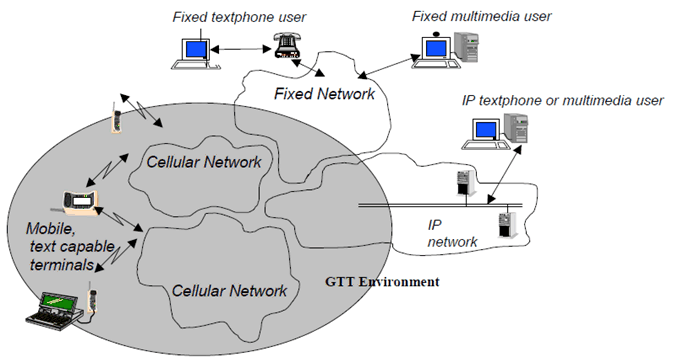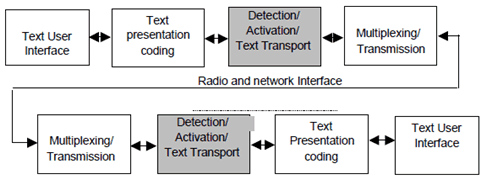Content for TS 23.226 Word version: 18.0.0
4 General Functions
4.1 Overview
4.1.1 General text transmission functions
4.1.2 Functions
4.1.3 Emergency service considerations
...
...
4 General Functions p. 8
4.1 Overview p. 8

Figure 1: General view of GTT feature provision within the different networks
(⇒ copy of original 3GPP image)
(⇒ copy of original 3GPP image)
Figure 1 shows a generalised view of the Global Text Telephony feature architecture for a third generation conversation service system. It shall combine different networks and network types and shall integrate text conversation systems already existent within these networks.
Global Text Telephony is a 3GPP Feature that can be included in 3GPP conversation services such as circuit switched voice telephony, circuit switched multimedia and IP multimedia conversation. It makes use of the infrastructure of the host environment and includes elements necessary for GTT in these environments.
The following description and figures describe the text specific parts and leave out many details of the host environment conversation service where text is included.
4.1.1 General text transmission functions p. 8
On the route from user to user, the text passes a set of functional elements.

Figure 2: Call flow for two mobile terminals with the same GTT transport method, using text conversation
(⇒ copy of original 3GPP image)
(⇒ copy of original 3GPP image)
Figure 2 shows the function chain when communicating within the network, between terminals operating in the same mode.

Figure 3: GTT general text transmission functions showing interworking
(⇒ copy of original 3GPP image)
(⇒ copy of original 3GPP image)
The view in Figure 3 is applicable to transport mechanisms and network environments when communicating in interworking mode between different environments.
4.1.2 Functions p. 9
4.1.2.1 Call Control and text media initiation p. 9
Before text conversation can begin, a call must be established. That is done with general call control functions of the host environment. GTT Elements detect the desire to establish a text channel, select a suitable transport mechanism, and activate transmission functions.
4.1.2.2 Presentation coding p. 9
The text in GTT shall be coded in a common presentation protocol, ITU-T Recommendation T.140 [5]. If necessary this presentation protocol shall be converted to or from any legacy mode character code used in other networks.
4.1.2.3 Transport and transmission host environments p. 9
When text transmission is activated, a suitable transmission method in the PLMN is selected. The appropriate method to use is selected according to the call environment. The environments valid for GTT are called GTT Host environments:
- IP Multimedia, according to IPMM subsystem with RFC 3261 (SIP).
- Circuit Switched Multimedia according to 3G.324.
- Circuit switched voice channel.
Digital data transmission in a data channel can be used for real time text conversation. For cases when only text conversation is wanted, there are a multitude of ways to implement that kind of communication. It can for example be done through a HTML based server, with an already established mainstream mechanisms that do not require text conversation specific functions to be stored in the terminals. An alternative may be to use GSM circuit switched data functions for text telephones that are compatible with the modem characteristics provided.
4.1.2.4 Multiplexing p. 9
The text transport is multiplexed in the network and radio interface according to normal procedures for the selected host environment.
4.1.2.5 Conversion p. 10
For text conversation with text telephones and text capable terminals in different networks or using different transport mechanisms, conversion functions may be used. Functions and procedures suitable for the conversion functions are described in ITU-T Recommendation H.248.2 [9], packages for Text telephony, Text Conversation and Call Type Discrimination.
4.1.2.6 Text capable terminal p. 10
By using the described GTT functions, a real time text conversation session can be conducted between GTT supported mobile Text Capable Terminals.. Different terminal function combinations and GTT host environments give different opportunities regarding combinations of text with voice and video. Valid combinations are:
- text only,
- alternating text and voice,
- simultaneous text and voice,
- simultaneous text and video,
- simultaneous text, video and voice.
4.1.2.7 Routing and location of CTM detection/conversion functions p. 10
There are three ways to include conversion functions between legacy text telephony and CTM.
- The "All transcoder solution". The CTM detection/conversion can be carried out within the transcoder function or within a separate node associated with the transcoder function. This approach means that no specific routing is required since the CTM detection/conversion function will be present in every speech call. Further explanations are found in Annex A.
- The "CTM circuit pool solution". The CTM detection/conversion function can be located in a dedicated resource pool in the access network or can be associated with transcoders in the core network. In these cases, the MSC/MSC Server requires an indication from the terminal that this CTM detection/conversion function is required. See TS 24.008 for the definition of this indication. This indication provides the necessary information to invoke the CTM detection/conversion function. TS 48.008 defines mechanisms for pool identities and selection. Further explanations are found in Annex B.
- The "CTM-SRF core network node solution". The CTM detection/conversion function can be placed in the core network as a separate CTM Special Resource Function (CTM-SRF), in which case routing functions are required to make sure calls are routed via the CTM-SRF for CTM detection/conversion. Routing can for example be based on subscriber data or specific call conditions available for MSC routing, e.g. emergency calls. Further explanations are found in Annex C.
4.1.3 Emergency service considerations p. 10
If an operator implementing GTT selects to offer access to Emergency Services through this feature for a specific host environment, the following must be considered.
If the emergency services only has limited types of text conversation devices, conversion from the users host environment to the one used by the emergency service may be configured.
If the calling party address and location information are provided in voice emergency calls, this information must be preserved also in text emergency calls, and not changed by any conversion or routing mechanisms introduced.
Other host environment specific considerations for emergency calls are described in clauses below.